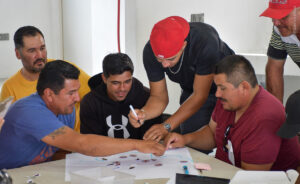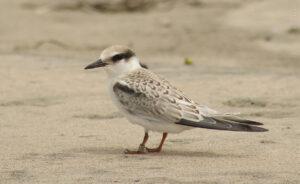The Belding’s Yellowthroat inhabits only in Baja California Sur, in the few permanent freshwater bodies of the state, as it requires oasis with perennial water mirror and emergent vegetation, such as Tule (Typha dominguensis) and the Common Reed (Phragmites australis).
Baja California Sur is the most arid state in the country, with an average annual rainfall of 180 mm, although throughout the state there are 32 oasis with a permanent water mirror and emergent vegetation, covering a little more than 20 km2. One of the typical species of these areas is the Belding’s Yellowthroat, which has been considered endangered by the Mexican government since 1994. It is estimated to have a population of between 1,000 and 2,500 adult birds, a very small population size for a songbird, especially when compared to similar species, such as the Common Yellowthroat (Geothlypis trichas) and the Black-winged Warbler (Geothlypis tolmiei), whose populations are estimated at 77 million and 11 million individuals, respectively.
There are different factors affecting the Belding’s Yellowthroat, both anthropogenic and of natural origin. Among the former, human settlements are regularly associated with bodies of freshwater, whether surface or subway, so that in many places there is excessive water use, in addition to pollution and, in general, changes in land use. As for natural impacts, fires and hurricanes are common phenomena that dramatically modify the oasis landscape. These factors can cause problems in the populations of the Belding’s Yellowthroat by reducing the area of reeds and tule.
Information about this species is scarce and much work remains to be done to integrate solid conservation and management programs to ensure its integrity. To date, two efforts aimed at the conservation of the species have been recognized: the action plan for the conservation of the Belding’s Yellowthroat and its habitats carried out by Pronatura Noroeste in 2011 and the request to the General Directorate of Wildlife for the inclusion of the La Poza and San Pedro del Palmar oasis as critical habitats (UABCS and Pronatura Noroeste 2017). However, these actions are still incipient as they have not reached the operational part. Currently, Pronatura Noroeste and UABCS have initiated the integration of the Action Program for the Conservation of Species at Risk (PACE) for the Belding’s Yellowthroat, in addition to exploring different oasis, such as San Ignacio, for which a scientific publication has already been generated (Carmona et al. 2020).
In addition, the PNO-UABCS duo, in collaboration with the environmental consultancy Cipactli, has carried out constant campaigns aimed at promoting birding tourism, as this activity could contribute to the conservation of the Peninsular Mascarita and the oasis in general (birding). Thus, it is necessary to generate a solid theoretical framework that allows taking appropriate management and conservation measures to ensure the survival of the species, which is synonymous with guaranteeing the permanence of the Baja California Sur oasis.
















